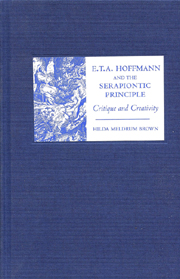Book contents
- Frontmatter
- Contents
- List of Illustrations
- Preface
- Acknowledgments
- List of Abbreviations
- Introduction: Approaches to the Serapiontic Principle
- Part 1
- Part 2
- 7 Frame Narrative and the Serapiontic Principle
- 8 From Visual to Verbal: Three Serapiontic Tales
- 9 The “Nachtseite der Natur” and the Serapiontic Principle
- 10 The Märchen and the Serapiontic Principle
- 11 The Serapiontic Principle: The Wider Critique
- Conclusion
- Select Bibliography
- Index
11 - The Serapiontic Principle: The Wider Critique
from Part 2
Published online by Cambridge University Press: 05 February 2013
- Frontmatter
- Contents
- List of Illustrations
- Preface
- Acknowledgments
- List of Abbreviations
- Introduction: Approaches to the Serapiontic Principle
- Part 1
- Part 2
- 7 Frame Narrative and the Serapiontic Principle
- 8 From Visual to Verbal: Three Serapiontic Tales
- 9 The “Nachtseite der Natur” and the Serapiontic Principle
- 10 The Märchen and the Serapiontic Principle
- 11 The Serapiontic Principle: The Wider Critique
- Conclusion
- Select Bibliography
- Index
Summary
Introduction
The Serapiontic Principle has revealed itself to be a multifaceted concept, some of its strands opening out onto issues of a general aesthetic nature, others generating specific narrative techniques. Lothar's broadly grounded “Erkenntnis der Duplizität,” for example, rooted philosophically as it is in a primary dualism between subject and object, leads directly, through the Serapiontic artist's “Erkenntnis” of this dual state of affairs to his adoption of an ironic stance (what Hoffmann himself termed “eine durchgehaltene Ironie). Whether in a humorous or a more serious vein, this is a hallmark of virtually all Hoffmann's literary oeuvre. Once more deriving from this fundamental dichotomy and starting point for his “poetology,” the creative “directive” suggested by the “Himmelsleiter” metaphor determines a pattern of two contrasting levels — earthbound and heavenbound, the one giving access to the other — over which the Serapiontic artist can range, thus potentially covering the entire scale of human experience. Hoffmann is the only Romantic artist who insists on treating both these levels evenhandedly. Scrupulous attention to his source material, to the vivid presentation of character traits and personal mannerisms (though not, however, pictorial description) together with an unerring ability to bring the two levels into a convincing juxtaposition is, in his finest works, so perfectly matched that the higher world of fantasy actually gains credibility from its relationship to the lower level and the reader has no problem in suspending disbelief.
- Type
- Chapter
- Information
- E. T. A. Hoffmann and the Serapiontic PrincipleCritique and Creativity, pp. 185 - 196Publisher: Boydell & BrewerPrint publication year: 2006



